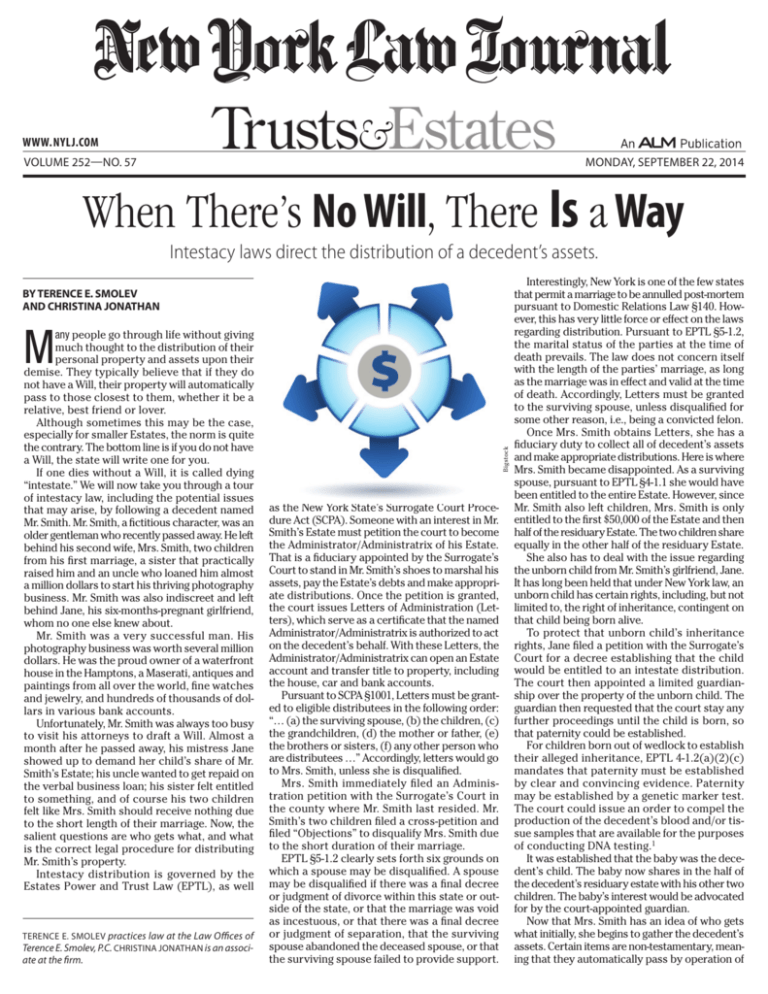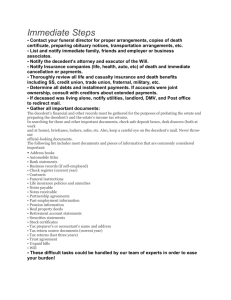
Trusts Estates
When There’s No Will, There Is a Way
www. NYLJ.com
monday, september 22, 2014
Volume 252—NO. 57
Intestacy laws direct the distribution of a decedent’s assets.
BY TERENCE E. SMOLEV
and CHRISTINA JONATHAN
Terence E. Smolev practices law at the Law Offices of
Terence E. Smolev, P.C. Christina Jonathan is an associate at the firm.
Bigstock
M
any people go through life without giving
much thought to the distribution of their
personal property and assets upon their
demise. They typically believe that if they do
not have a Will, their property will automatically
pass to those closest to them, whether it be a
relative, best friend or lover.
Although sometimes this may be the case,
especially for smaller Estates, the norm is quite
the contrary. The bottom line is if you do not have
a Will, the state will write one for you.
If one dies without a Will, it is called dying
“intestate.” We will now take you through a tour
of intestacy law, including the potential issues
that may arise, by following a decedent named
Mr. Smith. Mr. Smith, a fictitious character, was an
older gentleman who recently passed away. He left
behind his second wife, Mrs. Smith, two children
from his first marriage, a sister that practically
raised him and an uncle who loaned him almost
a million dollars to start his thriving photography
business. Mr. Smith was also indiscreet and left
behind Jane, his six-months-pregnant girlfriend,
whom no one else knew about.
Mr. Smith was a very successful man. His
photography business was worth several million
dollars. He was the proud owner of a waterfront
house in the Hamptons, a Maserati, antiques and
paintings from all over the world, fine watches
and jewelry, and hundreds of thousands of dollars in various bank accounts.
Unfortunately, Mr. Smith was always too busy
to visit his attorneys to draft a Will. Almost a
month after he passed away, his mistress Jane
showed up to demand her child’s share of Mr.
Smith’s Estate; his uncle wanted to get repaid on
the verbal business loan; his sister felt entitled
to something, and of course his two children
felt like Mrs. Smith should receive nothing due
to the short length of their marriage. Now, the
salient questions are who gets what, and what
is the correct legal procedure for distributing
Mr. Smith’s property.
Intestacy distribution is governed by the
Estates Power and Trust Law (EPTL), as well
as the New York State’s Surrogate Court Procedure Act (SCPA). Someone with an interest in Mr.
Smith’s Estate must petition the court to become
the Administrator/Administratrix of his Estate.
That is a fiduciary appointed by the Surrogate’s
Court to stand in Mr. Smith’s shoes to marshal his
assets, pay the Estate’s debts and make appropriate distributions. Once the petition is granted,
the court issues Letters of Administration (Letters), which serve as a certificate that the named
Administrator/Administratrix is authorized to act
on the decedent’s behalf. With these Letters, the
Administrator/Administratrix can open an Estate
account and transfer title to property, including
the house, car and bank accounts.
Pursuant to SCPA §1001, Letters must be granted to eligible distributees in the following order:
“… (a) the surviving spouse, (b) the children, (c)
the grandchildren, (d) the mother or father, (e)
the brothers or sisters, (f) any other person who
are distributees …” Accordingly, letters would go
to Mrs. Smith, unless she is disqualified.
Mrs. Smith immediately filed an Administration petition with the Surrogate’s Court in
the county where Mr. Smith last resided. Mr.
Smith’s two children filed a cross-petition and
filed “Objections” to disqualify Mrs. Smith due
to the short duration of their marriage.
EPTL §5-1.2 clearly sets forth six grounds on
which a spouse may be disqualified. A spouse
may be disqualified if there was a final decree
or judgment of divorce within this state or outside of the state, or that the marriage was void
as incestuous, or that there was a final decree
or judgment of separation, that the surviving
spouse abandoned the deceased spouse, or that
the surviving spouse failed to provide support.
Interestingly, New York is one of the few states
that permit a marriage to be annulled post-mortem
pursuant to Domestic Relations Law §140. However, this has very little force or effect on the laws
regarding distribution. Pursuant to EPTL §5-1.2,
the marital status of the parties at the time of
death prevails. The law does not concern itself
with the length of the parties’ marriage, as long
as the marriage was in effect and valid at the time
of death. Accordingly, Letters must be granted
to the surviving spouse, unless disqualified for
some other reason, i.e., being a convicted felon.
Once Mrs. Smith obtains Letters, she has a
fiduciary duty to collect all of decedent’s assets
and make appropriate distributions. Here is where
Mrs. Smith became disappointed. As a surviving
spouse, pursuant to EPTL §4-1.1 she would have
been entitled to the entire Estate. However, since
Mr. Smith also left children, Mrs. Smith is only
entitled to the first $50,000 of the Estate and then
half of the residuary Estate. The two children share
equally in the other half of the residuary Estate.
She also has to deal with the issue regarding
the unborn child from Mr. Smith’s girlfriend, Jane.
It has long been held that under New York law, an
unborn child has certain rights, including, but not
limited to, the right of inheritance, contingent on
that child being born alive.
To protect that unborn child’s inheritance
rights, Jane filed a petition with the Surrogate’s
Court for a decree establishing that the child
would be entitled to an intestate distribution.
The court then appointed a limited guardianship over the property of the unborn child. The
guardian then requested that the court stay any
further proceedings until the child is born, so
that paternity could be established.
For children born out of wedlock to establish
their alleged inheritance, EPTL 4-1.2(a)(2)(c)
mandates that paternity must be established
by clear and convincing evidence. Paternity
may be established by a genetic marker test.
The court could issue an order to compel the
production of the decedent’s blood and/or tissue samples that are available for the purposes
of conducting DNA testing.1
It was established that the baby was the decedent’s child. The baby now shares in the half of
the decedent’s residuary estate with his other two
children. The baby’s interest would be advocated
for by the court-appointed guardian.
Now that Mrs. Smith has an idea of who gets
what initially, she begins to gather the decedent’s
assets. Certain items are non-testamentary, meaning that they automatically pass by operation of
monday, september 22, 2014
law. Such items include joint bank accounts, deeds
written with a right of survivorship, life insurance
policies naming a beneficiary, etc.
As Mrs. Smith was gathering the documents
for the house in the Hamptons, she found the
deed, which surprisingly still had Mr. Smith’s
ex-wife’s name on it. It appeared that Mr. Smith
intended to take her off the deed, but again, did
not have time to go to his attorney to execute
the necessary documents. She also found the
separation agreement, wherein decedent’s ex-wife
agreed to relinquish her interest in the house
and sign any necessary documents to effectuate
the same. The separation agreement was then
incorporated into a final judgment of divorce.
Accordingly, Mr. Smith’s ex-wife could not claim
any interest in his house. Furthermore, if Mr. Smith
also neglected to remove the ex-wife’s name on
non-testamentary assets, the Surrogate’s Court
could intervene. For example, assuming the exwife relinquished her rights to the decedent’s life
insurance or pension plan, the court could direct
her to disgorge any proceeds received from these
non-testamentary assets. Those monies would
then become part of decedent’s residuary estate.2
Now that the house is part of the Estate, Mrs.
Smith has a choice. She may keep the house and
buy out the other half that would go to Mr. Smith’s
children, or she could simply sell the house and
put the proceeds into the Estate account. Considering the length of their marriage and the
problems the children were already raising, she
thought it was best to sell the house.
That was just the beginning of the fight. Within
the 40 days that she was married to Mr. Smith,
they traveled for a month straight. During their
travels, Mr. Smith bought her many exquisite art
and antiques from Europe, Asia and the Middle
East. The two children and the guardian over the
baby’s property argued that all of that personal
property belonged to the Estate and that they
were entitled to half of everything.
Instead of going to a hearing in the Surrogate’s
Court to determine whether or not the items were
gifted to Mrs. Smith, Mrs. Smith decided to distribute her gifts as though the property belonged
solely to the decedent. She followed the proper
procedure by having all the valuables appraised
and providing a detailed inventory to the children.
Any items that Mrs. Smith wanted to keep had
to be paid for at the appraised price; the same
applied to the children. Everything else was sold
and the monies went into the Estate account.
Mrs. Smith then had to make a decision regarding what she should do with the business, and
of course decedent’s uncle showed up to collect
the alleged business loan of $99,500. Mrs. Smith
had no idea how to run a photography business.
She decided to target his competitors, and found
another business that would buy decedent’s photography business, including all of the equipment,
and also retain his employees. She quickly jumped
on the deal and hired a forensic accounting firm
to complete the required business appraisal. She
collected $2.5 million from the sale of the business.
As far as decedent’s uncle was concerned, he
did not have any promissory note or documents
evidencing the money that he loaned Mr. Smith.
Instead, he had a copy of a cashed check made
directly to Mr. Smith almost two years before he
launched his business. This could be considered
a gift, or a personal loan. Without more evidence,
the uncle’s only option would be to file a claim
against the Estate as a creditor. Luckily, the children were on his side and convinced Mrs. Smith to
pay him half of what was allegedly owed to settle
the debt. Everything was put in writing and the
uncle executed a Receipt and Release form, which
was filed with the Surrogate’s Court.
Mr. Smith’s sister was unfortunately not entitled
to anything pursuant to intestacy laws. However,
the wife and children all knew how fond Mr. Smith
was of his sister and collectively agreed to give
her certain personal items and a percentage from
their shares of the residuary Estate.
Pursuant to SCPA §1001, Letters must
be granted to eligible distributees in
the following order: “(a) the surviving
spouse, (b) the children, (c) the grandchildren, (d) the mother or father, (e) the
brothers or sisters, (f) any other person
who are distributees.”
Mrs. Smith also had to figure out what to do
with the Maserati. The entire time she thought that
Mr. Smith owned the car outright. It turned out that
he actually had a lease with over $50,000 owed.
She had three choices as to how to proceed with
this vehicle. Firstly, she could surrender the car,
and then the Estate would be responsible for all
of the additional costs on the lease. Secondly, she
could take over the lease payments individually.
Thirdly, she could sell the car and pay off what
is owed to the bank, with any profits going into
the Estate account. She chose the third option.
It has been almost six months since Mrs.
Smith was granted Letters. She now has to
file an inventory with the court. The inventory form lists all of decedent’s assets, both
testamentary and non-testamentary. The nontestamentary assets are used to determine the
size of the decedent’s Estate. In this case, there
was the business at $2.5 million, the house at
$1.5 million, all of the appraised property at
$500,000 and the cash of $400,000, for a total
of $4.9 million. The court’s primary purpose
in having this form filed is to ensure that the
correct filing fee was paid by the petitioner.
Obtaining Letters is not free. The filing fee
is paid by the petitioner, and is determined by
SCPA §2402, based on the size of the Testamentary
Estate. Here, the filing fee was $1,250. Mrs. Smith
only paid $625 when she filed her Administration
petition, thinking that the house and business were
worth a lot less. She now has to pay the court the
The Law Offices of Terence
The Law
E. Smolev,
Offices
TheP.C.
of
Law
Terence
OfficesE.ofSmolev,
TerenceP.C.
E. Smolev, P.C.
100 Jericho Quadrangle 100 Jericho Quadrangle
100 Jericho Quadrangle
Suite 208
Suite 208
Suite 208
Jericho, NY 11753
Jericho, NY 11753
Jericho, NY 11753
516-931-9500 Fax: 516-977-2314
516-931-9500516-931-9500
Fax: 516-977-2314
Fax: 516-977-2314
www.smolevlaw.com
www.smolevlaw.com
www.smolevlaw.com
difference of $625 upon the filing on the Inventory
form. The $1,250 fee is the maximum filing fee,
and covers Estates that are valued over $500,000.
Mrs. Smith also needs to figure out if she has
to file Estate tax returns. Estate tax is a tax on
the decedent’s right to transfer the decedent’s
property. In New York state, if required, an Estate
tax return is due nine months after decedent’s
death, unless an extension is filed. An Estate is
subject to New York Estate tax if the decedent was
a resident of New York and the total of the federal
gross estate, plus the federal adjusted taxable gifts
and specific exemption, exceeds $2,062,500. Here,
even after the adjustments, the total was greater
than $2,062,500; therefore, Mrs. Smith had to file
the required Form ET-706.
For the federal government, an Estate tax
return is required if the Estate is greater than
$5,340,000. This Estate was just shy of that number; therefore, no federal return was required.
Nonetheless, it is recommended that a return be
filed to prevent the IRS from subjecting the Estate
to a potential future tax proceeding. The IRS could
assert that the valuation of the decedent’s assets
were much greater than what was reported. This
is fairly common when an Estate includes a lucrative business and extremely valuable art. The
IRS could always audit and claim that the Estate
was worth more than the threshold; however, if
a return is filed, the IRS only has three years to
make such an argument. Filing a return, whether
or not Estate taxes are due, prevents the Estate
from facing a potential audit after three years
from when the return was filed.
Now that all of the decedent’s property was
distributed and sold, Mrs. Smith has to file another
petition for Judicial Settlement of Account with
the court. Therein, she will also have to submit a
detailed accounting of all of decedent’s assets and
liabilities, including a schedule of creditor’s claims.
All interested parties, including the creditors will
then be served with an Accounting Citation.
If there are no Objections filed to Mrs. Smith’s
accounting, once the creditor’s claims are settled,
the court will issue a final order and decree that
allows Mrs. Smith to distribute the residuary
Estate and close the Estate.
This entire procedure, although simplified
in my example, could take several years. Mrs.
Smith’s story briefly outlines an Administrator’s
obligations. Each issue that she faced could have
taken months to resolve, coupled with heated
fights amongst the relatives. If only Mr. Smith
had a Will, his surviving relatives could have
also rested in peace after his demise.
•••••••••••••
••••••••••••••••
1. Matter of Estate of Ray. F. Morningstar, 17 A.D.3d 1060
(2005).
2. Estate of Landy v. Sondra Landy, 267 A.D.2d 142 (1999).
Reprinted with permission from the September 22, 2014 edition of the NEW YORK
LAW JOURNAL © 2014 ALM Media Properties, LLC. All rights reserved. Further
duplication without permission is prohibited. For information, contact 877-257-3382
or reprints@alm.com. # 070-10-14-01








